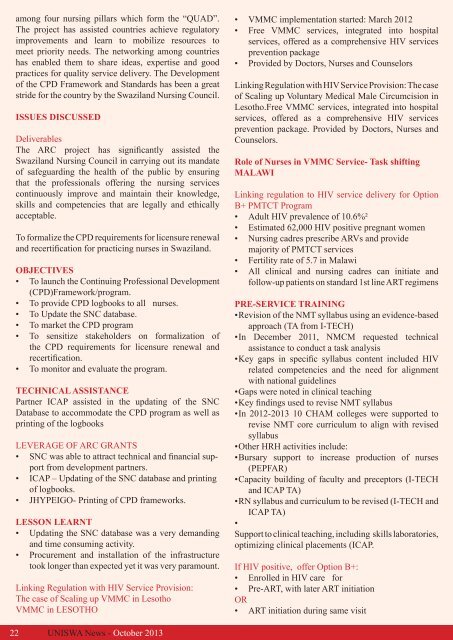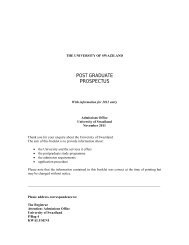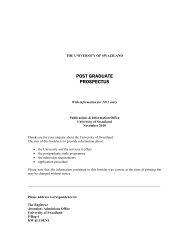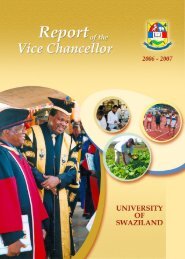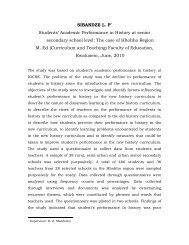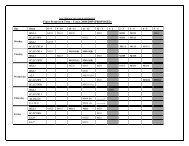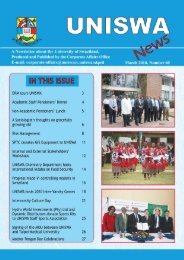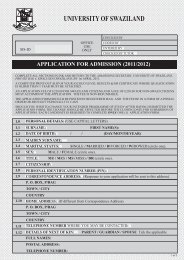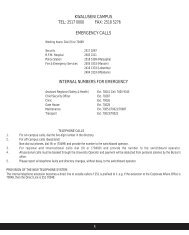UNISWA
October 2013 - University of Swaziland
October 2013 - University of Swaziland
- No tags were found...
You also want an ePaper? Increase the reach of your titles
YUMPU automatically turns print PDFs into web optimized ePapers that Google loves.
among four nursing pillars which form the “QUAD”.The project has assisted countries achieve regulatoryimprovements and learn to mobilize resources tomeet priority needs. The networking among countrieshas enabled them to share ideas, expertise and goodpractices for quality service delivery. The Developmentof the CPD Framework and Standards has been a greatstride for the country by the Swaziland Nursing Council.ISSUES DISCUSSEDDeliverablesThe ARC project has significantly assisted theSwaziland Nursing Council in carrying out its mandateof safeguarding the health of the public by ensuringthat the professionals offering the nursing servicescontinuously improve and maintain their knowledge,skills and competencies that are legally and ethicallyacceptable.To formalize the CPD requirements for licensure renewaland recertification for practicing nurses in Swaziland.OBJECTIVES• To launch the Continuing Professional Development(CPD)Framework/program.• To provide CPD logbooks to all nurses.• To Update the SNC database.• To market the CPD program• To sensitize stakeholders on formalization ofthe CPD requirements for licensure renewal andrecertification.• To monitor and evaluate the program.TECHNICAL ASSISTANCEPartner ICAP assisted in the updating of the SNCDatabase to accommodate the CPD program as well asprinting of the logbooksLEVERAGE OF ARC GRANTS• SNC was able to attract technical and financial supportfrom development partners.• ICAP – Updating of the SNC database and printingof logbooks.• JHYPEIGO- Printing of CPD frameworks.LESSON LEARNT• Updating the SNC database was a very demandingand time consuming activity.• Procurement and installation of the infrastructuretook longer than expected yet it was very paramount.Linking Regulation with HIV Service Provision:The case of Scaling up VMMC in LesothoVMMC in LESOTHO• VMMC implementation started: March 2012• Free VMMC services, integrated into hospitalservices, offered as a comprehensive HIV servicesprevention package• Provided by Doctors, Nurses and CounselorsLinking Regulation with HIV Service Provision: The caseof Scaling up Voluntary Medical Male Circumcision inLesotho.Free VMMC services, integrated into hospitalservices, offered as a comprehensive HIV servicesprevention package. Provided by Doctors, Nurses andCounselors.Role of Nurses in VMMC Service- Task shiftingMALAWILinking regulation to HIV service delivery for OptionB+ PMTCT Program• Adult HIV prevalence of 10.6%²• Estimated 62,000 HIV positive pregnant women• Nursing cadres prescribe ARVs and providemajority of PMTCT services• Fertility rate of 5.7 in Malawi• All clinical and nursing cadres can initiate andfollow-up patients on standard 1st line ART regimensPRE-SERVICE TRAINING• Revision of the NMT syllabus using an evidence-basedapproach (TA from I-TECH)• In December 2011, NMCM requested technicalassistance to conduct a task analysis• Key gaps in specific syllabus content included HIVrelated competencies and the need for alignmentwith national guidelines• Gaps were noted in clinical teaching• Key findings used to revise NMT syllabus• In 2012-2013 10 CHAM colleges were supported torevise NMT core curriculum to align with revisedsyllabus• Other HRH activities include:• Bursary support to increase production of nurses(PEPFAR)• Capacity building of faculty and preceptors (I-TECHand ICAP TA)• RN syllabus and curriculum to be revised (I-TECH andICAP TA)•Support to clinical teaching, including skills laboratories,optimizing clinical placements (ICAP.If HIV positive, offer Option B+:• Enrolled in HIV care for• Pre-ART, with later ART initiationOR• ART initiation during same visit22<strong>UNISWA</strong> News - October 2013


